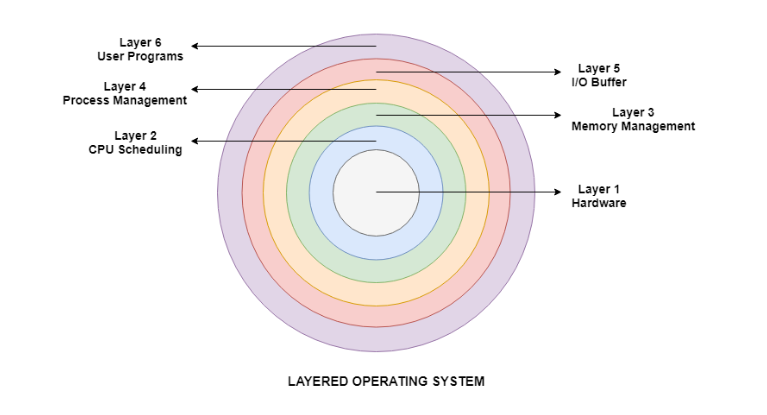
 Data Structure
Data Structure Networking
Networking RDBMS
RDBMS Operating System
Operating System Java
Java MS Excel
MS Excel iOS
iOS HTML
HTML CSS
CSS Android
Android Python
Python C Programming
C Programming C++
C++ C#
C# MongoDB
MongoDB MySQL
MySQL Javascript
Javascript PHP
PHP
- Selected Reading
- UPSC IAS Exams Notes
- Developer's Best Practices
- Questions and Answers
- Effective Resume Writing
- HR Interview Questions
- Computer Glossary
- Who is Who
Layered Operating System
The operating system is split into various layers In the layered operating system and each of the layers have different functionalities. This type of operating system was created as an improvement over the early monolithic systems.
Why Layering in Operating System?
Layering provides a distinct advantage in an operating system. All the layers can be defined separately and interact with each other as required. Also, it is easier to create, maintain and update the system if it is done in the form of layers. Change in one layer specification does not affect the rest of the layers.
Each of the layers in the operating system can only interact with the layers that are above and below it. The lowest layer handles the hardware and the uppermost layer deals with the user applications.
Layers in Layered Operating System
There are six layers in the layered operating system. A diagram demonstrating these layers is as follows:

Details about the six layers are:
Hardware
This layer interacts with the system hardware and coordinates with all the peripheral devices used such as printer, mouse, keyboard, scanner etc. The hardware layer is the lowest layer in the layered operating system architecture.
CPU Scheduling
This layer deals with scheduling the processes for the CPU. There are many scheduling queues that are used to handle processes. When the processes enter the system, they are put into the job queue. The processes that are ready to execute in the main memory are kept in the ready queue.
Memory Management
Memory management deals with memory and the moving of processes from disk to primary memory for execution and back again. This is handled by the third layer of the operating system.
Process Management
This layer is responsible for managing the processes i.e assigning the processor to a process at a time. This is known as process scheduling. The different algorithms used for process scheduling are FCFS (first come first served), SJF (shortest job first), priority scheduling, round-robin scheduling etc.
I/O Buffer
I/O devices are very important in the computer systems. They provide users with the means of interacting with the system. This layer handles the buffers for the I/O devices and makes sure that they work correctly.
User Programs
This is the highest layer in the layered operating system. This layer deals with the many user programs and applications that run in an operating system such as word processors, games, browsers etc.

